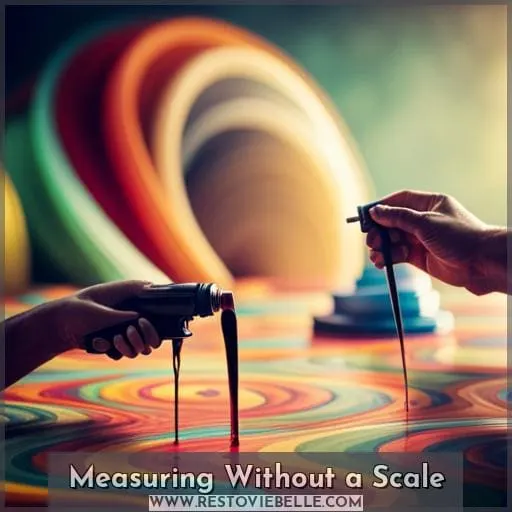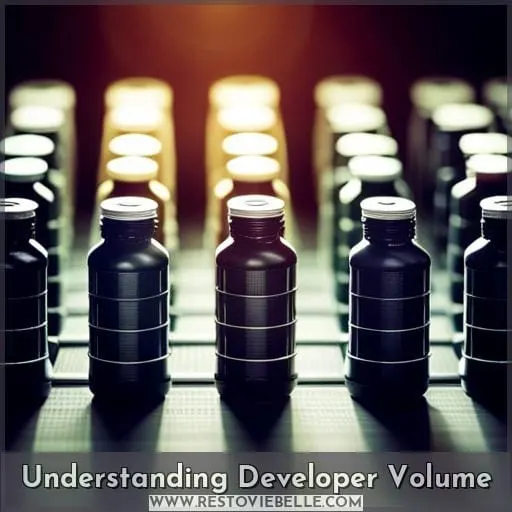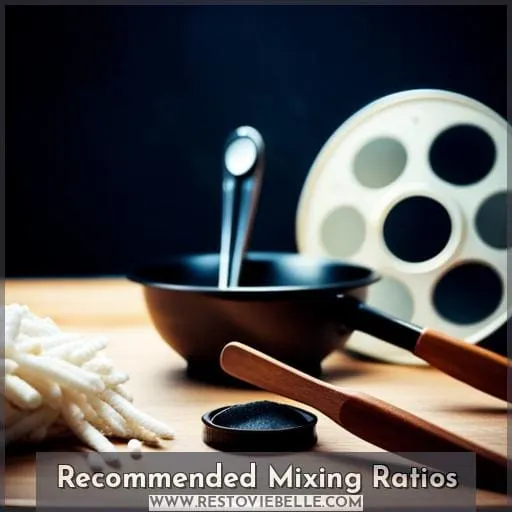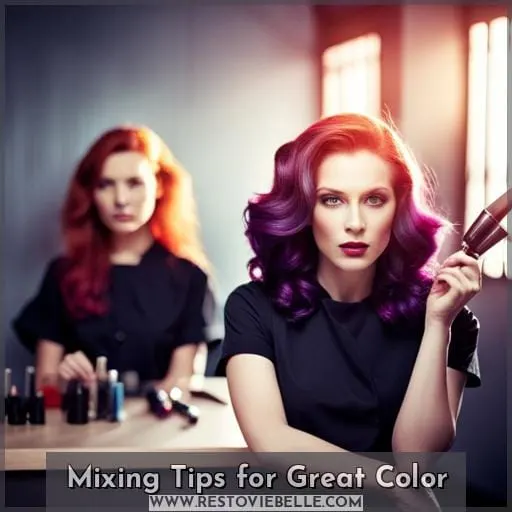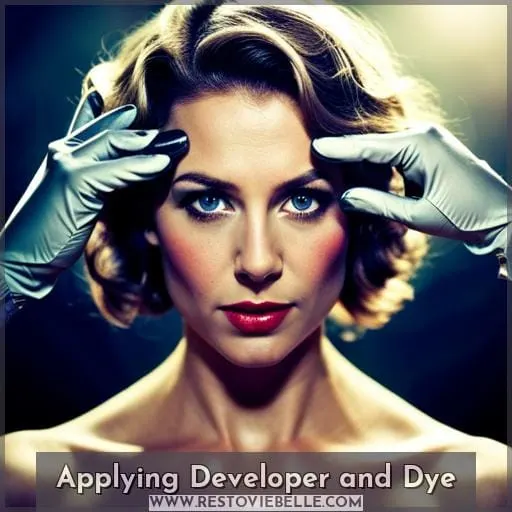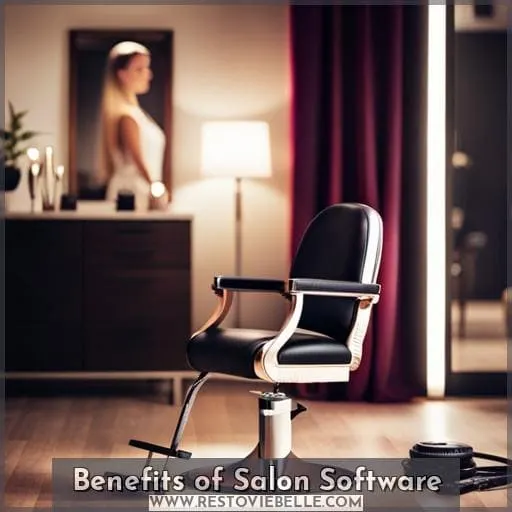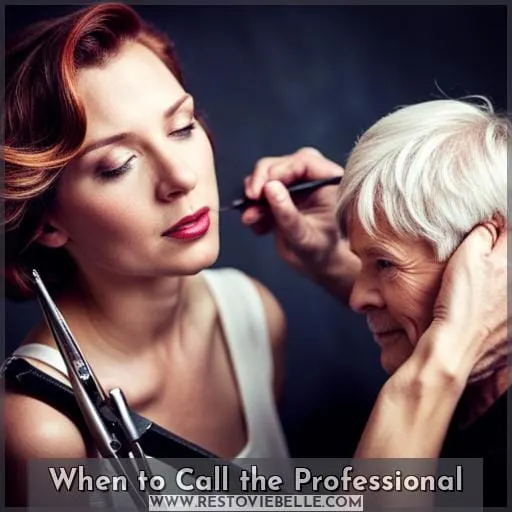This site is supported by our readers. We may earn a commission, at no cost to you, if you purchase through links.
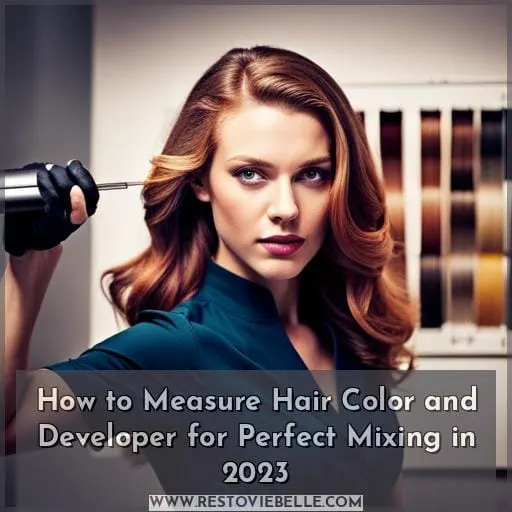 Looking to shake up your hair routine? With the right mix of hair color and developer, you can transform those locks into a bold new ‘do. Measuring these key ingredients is crucial for dyeing success. Ignore the scale – we’ll break down simple ways to get the perfect ratio.
Looking to shake up your hair routine? With the right mix of hair color and developer, you can transform those locks into a bold new ‘do. Measuring these key ingredients is crucial for dyeing success. Ignore the scale – we’ll break down simple ways to get the perfect ratio.
Whether you’re a DIY newbie or salon pro, we’ve got you covered. Our simple tricks ensure even color from root to tip. With the right pour, you’ll unlock shine, dimension, and vibrancy that looks natural.
Don’t stress – we’ll walk you through each mixing step so you can fearlessly rock that trendy ombre, balayage, or solid hue.
Let’s dive in and get creative with color!
Table Of Contents
Key Takeaways
- Use the recommended mixing ratio, usually 1 part dye to 2 parts developer, for even color results.
- Adjust the dye-to-developer ratio depending on the color goal, such as permanent versus demi-permanent dye.
- Choose the correct developer volume for your hair thickness and porosity to avoid damage.
- Measure precisely without a scale by using package markings or measuring cups for consistent, vibrant color.
Why Use Developer for Hair Dye?
You really need developer to properly activate and open up those cuticles when coloring your hair, honey. Mixing that luscious dye with just the right amount of developer is crucial for getting the vibrant, even tone you’re going for.
The developer acts like a key, unlocking those stubborn cuticles so the color pigments can really soak in. Make sure to follow the mixing ratios on the box, usually 1 part dye to 2 parts developer. Choosing the right strength developer lets you customize how light or dark you want to go.
Too much developer can actually damage your hair, so stick to the recommended levels. Measure precisely and saturate evenly from roots to ends for the flawless look you deserve. With the perfect developer-dye duo, you’ll have healthy, head-turning color in no time.
Choosing the Right Developer
Choosing the Right Developer
When selecting the proper developer for hair dye, it’s vital to choose the right volume based on your formula and desired result. Aim for a 1:2 mixing ratio, tweaking as necessary for varying lengths and thicknesses.
This fully activates the color molecules while preventing damage from too much developer.
Developer Strength Selection
Choosing the ideal strength to lift, deposit, and customize your shade depends on your goal. For subtle color changes, try 10 volume developer. To cover grays or lift a few shades, 20 volume is your best friend.
When lightening significantly or achieving a fantasy hue, 30 or 40 volume developer gets the job done. But beware, higher volumes often cause damage, so adjust your timing and nurture strands with conditioning treatments.
Ultimately, the developer strength should complement the color’s lift potential and your hair’s resilience.
Mixing Ratios for Formulas
If you don’t nail down the perfect proportions, your color will be a hot mess.
- Follow package instructions when selecting ratios.
- For permanent color, mix 1 part dye to 2 parts developer.
- Vary ratios based on hair thickness and porosity.
- Adjust the developer volume for the desired lift.
- Do test strands to customize for hair sensitivities.
When mixing hair color, carefully follow the instructions and do test strands. This ensures you achieve the perfect shade while protecting hair health.
Avoiding Damage from Overprocessing
Don’t overdo it with developer if you want healthy hair. Choosing the right developer strength prevents overprocessing and damage. Carefully measure dye-to-developer ratios to get the coverage you want without compromising hair health.
To avoid an uneven color result, always start with the recommended ratio based on your formula. Going overboard trying to overly lighten or darken hair leads to damage. Mixing consistency gives the best color while caring for hair’s integrity.
Consider hair sensitivities and err on the side of less developer rather than too much.
Measuring Without a Scale
When mixing hair color, getting the measurements right is crucial for even results. Without a scale, you can use the package markings or measuring cups to gauge the correct ratios of dye and developer.
Use Package Marks
Tomorrow marks a new era of estimating amounts by sight and improvising your way to colorful locks. While not ideal, you can use the measurement marks on the hair color and developer packages as a guide for mixing ratios.
Choosing the right volume developer and closely following instructions prevents hair damage. For best results, use metal-free tools like plastic measuring cups. Getting professional help ensures proper mixing and application for your hair goals.
Use Measuring Cups
Make like a baker and grab measuring cups to get the dye-developer ratio on point. Use cups marked with ounces or milliliters for consistent mixing. Kitchen cups work if salon cups aren’t available. Check product packaging for guidance on standard mixing quantities. While a digital scale provides the most precision, cups allow adequate mixing without one.
Ultimately, consistency using any tool is key for even color results and avoiding an ashy or brassy mishap.
| Method | Pros | Cons |
|---|---|---|
| Kitchen Measuring Cups | Convenient, Common | Less Precise |
| Salon Measuring Cups | Precise Measurements | Must Purchase Specifically |
| Product Package Guides | Follows Instructions | Varies by Brand |
Understanding Developer Volume
You’ll wanna go with a higher volume developer for any major color changes. Choosing the right developer is crucial for achieving your ideal shade. Developer comes in different strengths, or volumes, typically ranging from 10 to 40.
Volume refers to the percentage of hydrogen peroxide in the solution. The higher the volume, the more it will lighten and lift your hair.
For subtle, demi-permanent gloss treatments, a 10 volume will do the trick. Anything more dramatic calls for 20 or 30 volume developer to really activate those color molecules. With fashion colors, a 30 volume helps deposit the most pigment for maximum vibrancy.
Just beware, higher volumes mean more damage, so treat your strands gently afterwards.
Understanding how to pick the ideal developer volume will empower you to get the hair hues you dream of.
Recommended Mixing Ratios
When customizing your color, it’s crucial to use the right mixing ratio of dye to developer. For demi-permanent colors, use a 1:1 ratio; for permanent color, use a 1:2 ratio; and for highlift blonding, use a 1:5 ratio of color to developer.
The proper ratio is key to ensuring even coverage and avoiding damage. Varying the dye-to-developer ratio depending on the type of color service helps guarantee optimal results.
1:1 Ratio
You’d be wise to avoid the 1:1 ratio, as it often leads to lackluster results. For vivid, even color, blend one part dye with two parts developer. No scale? Eyeball it! Still, precise blending is crucial. Consider your client’s hair factors, and don’t shy away from salon software for easier color management.
1:1.5 Ratio
Pouring the perfect mixture that saturates every strand. Carefully measuring one part color to one and a half parts developer activates maximum vibrancy in those highlighted tresses. Tailoring ratios for each client prevents damage while optimizing shine and longevity.
Consult the professional colorist to determine your ideal ratio for stunning, sensational color. Back bar management and stockroom processes make mixing flow smoothly. Appointment optimization increases revenue while easing scheduling.
1:2 Ratio
Adding twice as much developer as color boosts lifting and lightening for permanent changes. For vivid colors or multi-tonal looks, use a 1:2 dye-to-developer ratio. With 40 volume developer, you can really customize and intensify hues.
Stick to 10 or 20 for subtle color blends. Too much developer risks damage, so know your client’s hair.
Mixing Tips for Great Color
To really make those locks sing, be the chef and whip up the perfect dye recipe by focusing on your hair’s length and following the directions. When customizing color, think about your hair’s condition. Dry or damaged hair may need a more dilute developer or gentler formula.
To get the most out of your products:
- Use exact measurements for consistency
- Mix small batches to avoid waste
- Store leftovers properly for touch-ups
By understanding your hair’s needs and handling color carefully, your artistic vision will come through beautifully. Your clients will have rich, vibrant color that brings out their inner radiance.
Applying Developer and Dye
Applying developer and dye. You’re ready to bust out the brushes and get this color party started! Make sure you’ve got your tint bowl and brushes prepped before you begin mixing – this’ll help ensure your color formula stays consistent from root to tip.
When applying the developer and dye, start at the roots and work your way down in sections, saturating each strand thoroughly. Use downward brush strokes and really work the formula into the hair for maximum coverage.
Customize as you go, using lighter strokes on more sensitive areas around the hairline and nape of the neck.
Overuse Risks and Damage
Don’t fry your locks by overdoing the developer. Mixing up too much developer or leaving it on too long can really damage your hair.
- Dry, brittle hair
- Breakage
- Split ends
- Overprocessed, gummy texture
- Weakened strands
- Severe dryness
- Excess lift of underlying pigment
To keep your hair healthy, follow the manufacturer’s instructions carefully. Use a weaker volume if you have fragile or color-treated hair. And don’t overlap lightened sections. Your stylist can help determine the optimal timing and formulation.
With some care, you can achieve beautiful, vibrant color without compromising the integrity of your strands.
Benefits of Salon Software
When mixing and applying hair color, precision is key. Salon software can boost formula management efficiency, optimize appointments through scheduling features, and achieve more consistent color results to build your reputation.
Formula Management Efficiency
We’ll optimize mixing, reduce waste, and keep clients coming back by using salon software for efficient color formula management. With reliable formulas and consistent mixing, you’ll get precise, vibrant color results every time.
Your clients will love how their new ‘dos look just as stunning weeks later. Accurate record-keeping helps you recreate custom colors perfectly. Managing formulas digitally streamlines processing and ordering. Less guessing equals less waste.
The right salon software boosts efficiency so you can focus on stunning color artistry.
– Appointment Optimization Features
Not needing to constantly restock and remeasure all your hair products saves you tons of time to utilize focusing on clients. Salon software optimizes your appointment bookings through intelligent scheduling algorithms.
This allows you to effortlessly arrange back-to-back clients needing similar hair color formulas and techniques. Auto-generated material orders also ensure you never run short of dye or developer again.
Digital record keeping minimizes product waste from remnants or unused mixtures. Overall, savvy salon tech grants you more hours in the day for your passion: creating stunning looks that make clients beam.
– Consistent Results and Reputation
Consistency is key when mixing colors to uphold your salon’s reputation. Achieving consistent color results requires precise mixing each time. Use quality dyes, a digital scale, and adhere to the recommended developer ratios.
With the proper tools and expert techniques, your clients will leave with gorgeous, vibrant color and spread the word about your unparalleled skills.
When to Call the Professional
Though DIYing your locks seems like a breeze, ’tis best to ring the experts when aiming for a major change or to troubleshoot a botched job.
Here’s when professional assistance is highly recommended:
- Wanting to go more than 2 shades lighter or darker. Drastic color changes can damage hair without expert techniques.
- Correcting at-home color gone wrong. Professionals have the skills to even out patchy dye jobs.
- Dealing with overly brassy or ashy results. They’ll know how to tone and customize the shade.
- Needing special treatments like highlights, balayage, or vivid colors. Let the experts handle intricate color jobs.
With the right guidance, you can achieve your dream hue without harming your hair. Don’t be afraid to book a salon consultation, especially if you want a major color makeover.
Conclusion
Want to achieve perfect hair color at home but unsure how to measure the dye and developer? Let the professionals take over. Without precise tools like a digital scale, getting the right mixing ratio is too tricky.
One misstep risks uneven color or damaged strands. Save yourself stress and book an appointment with an expert colorist. They have all the tools, knowledge and talent to provide the ideal, long-lasting color that flatters your features.


